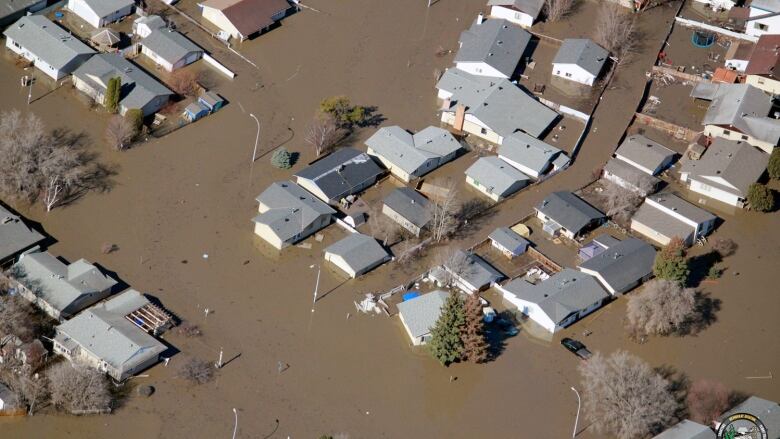Following Fort McMurray flood, mayor calls for additional financial aid
Damages to residences alone could top $100 million, Don Scott says

Without long-term financial assistance, many people in Fort McMurray whose homes and businesses were devastated by spring flooding will face financial ruin, says the region's mayor.
"In the big picture, we are going to need massive help. It wouldn't surprise me if the damages just to the residences was over $100 million. This is a massive disaster," said Don Scott, mayor of the Regional Municipality of Wood Buffalo.
He saidmost evacuees don'thave adequate property insurance to cover the damages.
Scott is calling on the federal and provincial governments to extend disaster relief funding to the nearly 13,000 people forced from their homes last week.
"Very few people have coverage," he said in an interview Sunday with CBC News.
"The average coverage that I saw, and very few people had it, was $10,000. And I would say, the average person, the damage I saw it varied from place to place was over $120,000, so this could put people in financial ruin."
'Recovery phase'
Scott said emergency cash for evacuees, announced last week by the Alberta government, will only provide temporary relief. The payments $1,250 for adults and $500 for children will cost the province $11.7 million for one week, Premier Jason Kenney said Wednesday.
Scott said many homeowners and businesses will struggle to rebuild if they don't get additional help.
Kenney has said that the Fort McMurray flood should qualify for the province's Disaster Recovery Program.
Under that program, the government would provide some financial support for recovery costs for critical public infrastructure and non-insured private infrastructure.
The area is now in "the recovery phase," Scott Davis, director of Emergency Management for the Regional Municipality of Wood Buffalo, said Monday.
Power has been turned back on for some 4,000 homes in the area, Davis said.
A boil-water advisory is still in place for all neighbourhoods in Fort McMurray, Anzac, Draper, Gregoire Lake Estates and Saprae Creek Estates.
Alberta Health Services (AHS) will not remove the advisory until all of the 375-kilometre potable water distribution system has been flushed, disinfected and tested, according to a release from the regional municipality. The advisory will be lifted incrementally, as each phase of the work is completed and then approved by AHS and Alberta Environment and Parks.
That work, which will be done in five phases,is expected to start Friday and finish in early September, the release said.
Fort McMurray has been hit hard by natural and economic disasters in recent years.
Many residents are still dealingwith the aftermath of the 2016 wildfire, thecostliest disaster for insurers in Canadian history.In all, about 2,400 homes and buildings burned in the fire and many homeowners lacked the proper insurance,slowing rebuild efforts.
Meanwhile, people in the northern Alberta community are reeling from job losses related to the pandemic and a gutting drop in oil prices.
People who have lost everything for a second time maydecide to leave the community altogether, Scott said.

The flooding began April 26, when a 25-kilometre sheet of ice effectively dammed the Athabasca River, forcing the Clearwater River to reverse course and flood the city's downtown core. An estimated 1,230 structures were damaged.
The last evacuation orders were lifted late Saturday but it may be weeks before people can truly return home.
Many homes swamped by flooding remain uninhabitable. Basements remain waterlogged and caked with mud. There are concerns about asbestos and mould.
With many homes unsafe to live in, the municipality announced on the weekend that emergency housing provided through the Red Cross was being extended until May 10.
Red Cross is also providing flood cleanup kits to residents, Davis said Monday.
'Salvage what we can'
Brad McCoy, president of Norfort Gymnastics Association, said the gym, which overlooks the Clearwater River, was flooded with more than five feet of water.
The waters have receded but the gym remains caked with a thick layer of river mud.
"It looked like a mud bomb when off in there," he said. "At the end of the day, it's probably a lot worse than we thought."
McCoy doubts the non-profit agency's insurance policy will cover the damages.
"We don't know if we have insurance. In fact, we're pretty sure we don't," he said. "Hopefully we can get some support from the city and the provincial government but right now we're just trying to clean up and salvage what we can.
"Are we going to make it through? Absolutely ... But at the end of the day, it's going to be close."
The recovery period is going to be very long and very difficult.- Don Scott
Scott said he has been in talks with provincial and federal officials and remains optimistic that additional relief is coming for evacuees.
Even with long-term financial aid, he expects it will take several months for the community to recover.
"Unfortunately, the difficulty is, people are really back in only to assess the damage," Scott said.
"The recovery period is going to be very long and very difficult."
With files from Raffy Boudjikanian and Samuel Martin












_(720p).jpg)


 OFFICIAL HD MUSIC VIDEO.jpg)
.jpg)



























































































